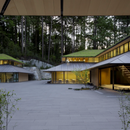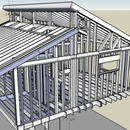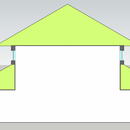Double-Hip Roof with Clerestory Windows
Here in the PNW the idea of clerestory windows closer to the interior of a house is attractive because it’s very dim most of the year, and even very large windows don’t bring that much light far in on overcast days. However with a double shed (or offset gable?) design, it seems like a cathedral ceiling is necessary, which comes with its own set of drawbacks and doesn’t seem like a particularly resilient design.
Compared to the double shed/offset gable clerestory windows, what would be the pros/cons of a double hip roof with clerestory windows? Obviously it could be a double gable instead, but let’s go with double hip for the sake of this discussion.
Ones I can think of off the top of my head:
Pros: no cathedral ceiling necessary, visually interesting, potentially more robust to wind loads
Cons: more expensive, more more complex, doesn’t bring light as far into the interior
GBA Detail Library
A collection of one thousand construction details organized by climate and house part












Replies
Andy,
It seems like you are introducing a more complex design when a simpler one would work fine. There's no reason you can't use a cathedral ceiling if it's done correctly. For five design options, see https://www.greenbuildingadvisor.com/article/five-cathedral-ceilings-that-work.
But maybe you're really asking how to make the home interior brighter. One option would be to do a lighting design and use LEDs that replicate natural light with good color rendering. (Some "bulbs" are tunable as well, which would allow you to program them to produce a more natural lighting effect based on the time of day.)
Andy,
The big complication is that all your roof loads now fall in a location where you would prefer to have open interior space, meaning you have to pick them up with posts and beams that otherwise wouldn't be necessary.
Offset shed roofs were quite popular in the PNW in the 70s or 80s. Their disappearance had a few causes.
-The high cathedral roof only worked when the space below was one open room. Dividing that space below was difficult.
- The quality of light coming fr0m a long narrow slit was never that great.
- The high clerestory windows trapped heat and were difficult to operate.
- The exterior of the houses never looked great.
Working in the PNW, my own preference is to bring light down into the interior in selected spots using either roof lanterns or shed dormers. Here is a photo of a house I designed using those strategies where the chimney doubles as a roof lantern.
Following Steve Knapp's suggestion re using lighting to brighten the house - IMO good lighting design starts with light that is reflected, preferably off a white ceiling. Reflected light reduces glare and makes it easier to see for a given amount of light. Cove lighting is one way to incorporate uplighting.
I agree with the notion of reflected lighting--that's in part why I thought this design would be attractive, because depending on how the windows and pop up roof section are configured, most of the light would be reflecting off of the walls of the pop up section.
There is one more alternative. I used two 18' Sun Tubes from Natural Light: http://nltubular.com/. I used the crystalline diffuser; they yield a really surprising amount of light ( equivalent to a 1000 watt incandescent bulb) and you can place them just where you want them.
The NL sun tubes include no particular provisions for thermal performance or air sealing, but they were small enough in area not to hurt us too much in the energy model. We got a good blower-door test.
I realize natural light is preferable, but regarding LED lighting, I recommend reading this article by David Warfel, a lighting designer I have worked with (be sure to open the pdf version for the meat of the information): The Lighting Power of LEDs.
Hi Kiley,
It's a great article! Would you consider doing a follow-up on one regarding PWM dimming? It's very common in LED lighting and unfortunately triggers migraines for a lot of people: https://www.notebookcheck.net/Why-Pulse-Width-Modulation-PWM-is-such-a-headache.270240.0.html
I think it's not something that is very well known in the lighting industry at this point in time.